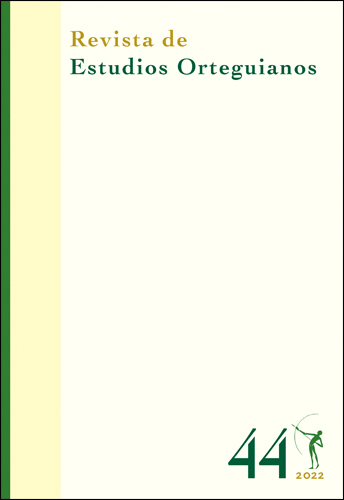Art without human content in Ortega, Worringer, and Sontag
DOI:
https://doi.org/10.63487/reo.105Keywords:
Ortega y Gasset, Sontag, Worringer, art, dehumanizationAbstract
This article studies the influence of Ortega y Gasset on Sontag. The two thinkers argue that the most characteristic of contemporary art is its rejection of human content. However, both present different interpretations regarding the social meaning of the appearance of art without human content. While Ortega interprets the dehumanization of art as the manifestation of the puerility of his time, Sontag affirms that it is a very mature response to modern society. At the same time, this study attempts to show Worringer’s influence on the Ortega’s interpretation of artistic realism.
Downloads
References
ALEXANDRA VLAD, S. (2009): “Dadá: Bucarest, Zúrich, París. Una Historia del Dadaísmo”, Quintana: revista de estudios do Departamento de Historia da Arte, 8: 8, pp. 271-279.
BARASCH, M. (1998): Modern Theories of Art, 2. From Impressionism to Kandinsky. New York University Press.
BORGES, J. L. (1973): “Primera conversación”, en F. SERRENTINO: Siete conversaciones con Jorge Luis Borges. Buenos Aires: Casa Pardo.
— (1997): Textos recobrados 1919-1929. Buenos Aires: Emecé.
BRETON, A. (2001): Manifiestos del surrealismo. Buenos Aires: Argonauta.
CARMONA, E. (2017): Cubismo(s) y experiencia de la modernidad (folleto para la exposición del mismo título). Museo Nacional Centro de Arte Reina Sofía.
DANTO, A. C. (1997): Después del fin del arte. Barcelona: Paidós.
FERRARI NIETO, E. (2013): “El recorrido metafísico de La deshumanización del arte”, Anuario Filosófico, 46: 3, pp. 593-616.
LAUTREAMONT (2006): Los cantos de Maldoror. Villa Clara: Sed de belleza.
LIPPS, Th. (1924): Los fundamentos de la estética: la contemplación estética y las artes plástica. Madrid: Daniel Jorro.
MCROBBIE, A. (1991): “The Modernist Style of Susan Sontag”, Feminist Review, 38, pp. 1-19.
MORA, A. (2017): “André Breton: las defecciones surrealistas”, Sociología Histórica, 7, pp. 321-344.
MORÓN ARROYO, C. (1968): El sistema de Ortega y Gasset. Madrid: Alcalá.
ORTEGA Y GASSET, J. (2004-2010): Obras completas, 10 vols. Madrid: Fundación José Ortega y Gasset / Taurus.
REYES, A. (1997): El deslinde. Prolegómenos a la teoría literaria, en Obras Completas XV. México: Fondo de Cultura Económica.
SONTAG, S. (2013): Essays of the 1960s and 70s. New York: Library of America
— (2014): Contra la interpretación y otros ensayos. Barcelona: Debolsillo.
TORRE, G. de. (1925): Literaturas europeas de vanguardia. Madrid: Rafael Carro Raggio.
TOYOHIRA, T. (2017): “Theodor Lipps y el concepto de estilo en la estética orteguiana”, Revista de Estudios Orteguianos, 35, pp. 161-187.
TZARA, T. (2011): Seven Dada Manifestos and Lampisteries. Richmond: Alma Collection.
VALDEARCOS, E. (2007): “El arte de vanguardia pic- tórica (1ª mitad s. XX)”, Clio, 33, pp. 1-25.
WORRINGER, W. (1997): Abstracción y naturaleza. México: Fondo de Cultura Económica.





